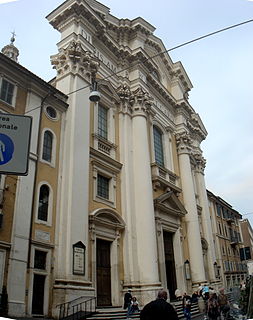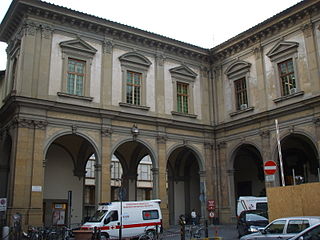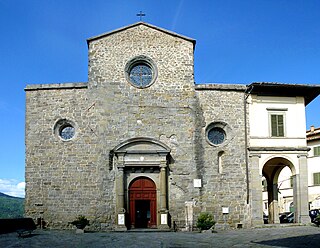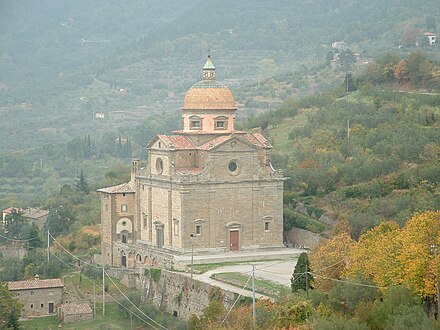
Sant'Ambrogio e Carlo al Corso is a basilica church in Rome, Italy, facing onto the central part of the Via del Corso. The apse of the church faces across the street, the Mausoleum of Augustus on Via di Ripetta.

Santa Maria in Vallicella, also called Chiesa Nuova, is a church in Rome, Italy, which today faces onto the main thoroughfare of the Corso Vittorio Emanuele and the corner of Via della Chiesa Nuova. It is the principal church of the Oratorians, a religious congregation of secular priests, founded by St Philip Neri in 1561 at a time in the 16th century when the Counter Reformation saw the emergence of a number of new religious organisations such as the Society of Jesus (Jesuits), the Theatines and the Barnabites.

Santa Maria in Via Lata is a church on the Via del Corso, in Rome, Italy. It stands diagonal from the church of San Marcello al Corso.

San Nicola da Tolentino agli Orti Sallustiani is a church in Rome. It is one of the two national churches of Armenia. The church was built for the Discalced Augustinians in 1599, and originally dedicated to the 13th century Augustinian monk, St. Nicholas of Tolentino.

San Francesco is a basilica church in Siena, Tuscany, Italy.

San Raimondo, also called San Raimondo al Refugio, is a Baroque style, Roman Catholic church located on the intersection of Via del Refugio and Via di Fiera Vecchia, in the Terzo of Camollia of the city of Siena, region of Tuscany, Italy. The church is dedicated to St Raymond of Pennafort.

Arezzo Cathedral is a Roman Catholic cathedral in the city of Arezzo in Tuscany, Italy. It is located on the site of a pre-existing Palaeo-Christian church and, perhaps, of the ancient city's acropolis.

The Hospital of Santa Maria Nuova is the oldest hospital still active in Florence, Italy.

The Diocesan Museum in Cortona is an art museum in Cortona, Tuscany, Italy. Located on the former site of the local Church of Gesù, it houses works of art by artists such as Fra Angelico, Pietro Lorenzetti, Bartolomeo della Gatta, Luca Signorelli and Sassetta. The oldest item in the museum is a marble Roman sarcophagus, depicting depicts the battle of Dionysus.

Cortona Cathedral is a Roman Catholic cathedral in Cortona, Tuscany, central Italy, dedicated to the Assumption of the Blessed Virgin Mary. It was the seat of the Bishops of Cortona from 1507 to 1986, and is now a co-cathedral in the present Diocese of Arezzo-Cortona-Sansepolcro.

San Niccolò al Carmine, also called Santa Maria del Carmine is a Renaissance style, Roman Catholic church and monastery located in Pian dei Mantellini #30, near the corner of Via della Diana in the Terzo de Citta of Siena, region of Tuscany, Italy. The church now serves as the Oratory for the Contrada of Pantera. Across the street from the belltower is the Palazzo Celsi Pollini. North along Pian dei Mantellini, toward the Arco delle Due Porte, and on the same side of the street are a number of palaces built around what was once the Monastery of the Derelict Women: in order they are the Neoclassical Palazzo Incontri, the Palazzo Ravissa and the Palazzo Segardi.

Basilica of Santa Margherita is a Neo-gothic style, Roman Catholic church, located just outside the Tuscan town of Cortona, Italy, at the intersection of Via delle Santucce and Via Sant Margherita, on a hill just below the Fortezza Medicea, and dedicated to a native saint of town.

The Complesso di San Firenze is a 17th-century Baroque-style building, consisting of a church, palace, and former oratory, located on the southeast corner of the saucer-shaped piazza of San Firenze, located in the quartiere of Santa Croce in central Florence, region of Tuscany, Italy. The buildings were commissioned by the Oratorians of Saint Philip Neri.
The Collegiata di Santa Maria della Reggia is a Renaissance-style, Roman Catholic church located in Umbertide, province of Perugia, region of Umbria, Italy. In 2015, it was part of the parish of San Giovanni Battista.

San Francesco is a Romanesque and Gothic-style, Roman Catholic church located at Piazza San Francesco in Pescia, region of Tuscany, Italy.
Sant'Antonio di Padova is a Neoclassic-style, Roman Catholic church located facing Piazza Magagnini in the town of Santa Maria Nuova, region of Marche, Italy.
Fossombrone Cathedral is a Roman Catholic cathedral dedicated to Saint Aldebrandus and Saint Augustine located in the Piazza Mazzini at the end of Corso Garibaldi in the center of the town of Fossombrone in the province of Pesaro and Urbino in the region of Marche, Italy. Formerly the cathedral of the Diocese of Fossombrone, since 1986 it has been a co-cathedral of the Diocese of Fano-Fossombrone-Cagli-Pergola.

Cingoli Cathedral is a Baroque Roman Catholic cathedral dedicated to the Assumption of the Virgin Mary in the town of Cingoli, province of Macerata, region of Marche, Italy. It stands on the central piazza opposite the town hall.
San Girolamo is a 15th-century Roman Catholic church located in Spello, province of Perugia, region of Umbria, Italy.






















